
This book provides best practices for creating accessible educational materials.
- Subject:
- Open Educational Resources & Practice
- Material Type:
- Reading
- Teaching/Learning Strategy
- Author:
- Heather Caprette
- Date Added:
- 10/20/2023

This collection includes openly licensed resources on the topic of open pedagogy. Open Pedagogy is a group of teaching strategies that focus on developing renewable assignments in which students use, engage with, or create openly licensed materials.
Collection thumbnail Open Pedagogy is from Unsplash.

This book provides best practices for creating accessible educational materials.

The Changing Story gives you assignments, resources, and examples to use in your teaching and learning. It will also help you think of ways digital stories can be used in your teaching, and help students harness the power of visual storytelling.

No matter how long you’ve been an advocate of OER, you may sometimes feel like you need a (fun and nuanced) refresher on the nuts and bolts of “open.” This webinar will engage a panel of experts in a discussion ranging from the basics of copyright and Creative Commons licensing to the tough questions we inevitably encounter when working with open resources.
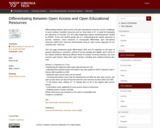
Differentiating open access and open educational resource can be a challenge in some contexts. Excellent resources such as "How Open Is It?: A Guide for Evaluating the Openness of Journals" (CC BY) https://sparcopen.org/our-work/howopenisit created by SPARC, PLOS, and OASPA greatly aid us in understanding the relative openness of journals. However, visual resources to conceptually differentiate open educational resources (OER) from resources disseminated using an open access approach do not currently exist. Until now.
This one page introductory guide differentiates OER and OA materials on the basis of purpose (teaching vs. research), method of access (analog and digital), and in terms of the relative freedoms offered by different levels of Creative Commons licenses, the most common open license. Many other open licenses, including open software licenses also exist.

This is a hands-on course where you will learn and demonstrate your skills in using digital technologies for collaborative OER development culminating in the development of an OER learning sequence.
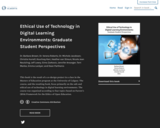
Short Description:
This book is the result of a co-design project in a class in the Masters of Education program at the University of Calgary. The course, and the resulting book, focus primarily on the safe and ethical use of technology in digital learning environments. The course was organized according to four topics based on Farrow’s (2016) Framework for the Ethics of Open Education.This is the first of 2 Versions of this pressbook. Click on Volume 2 for information.
Long Description:
This book is the result of a co-design project in a class in the Masters of Education program at the University of Calgary. The course, and the resulting book, focus primarily on the safe and ethical use of technology in digital learning environments. The course was organized according to four topics based on Farrow’s (2016) Framework for the Ethics of Open Education. Students were asked to review, analyze, and synthesize each topic from three meta-ethical theoretical positions: deontological, consequentialist, and virtue ethical (Farrow, 2016). The chapters in this open educational resource (OER) were co-designed using a participatory pedagogy with the intention to share and mobilize knowledge with a broader audience. The first three chapters in the book discuss specific ethical considerations related to technologies such as Artificial Intelligence (AI) , social networking services (SNS), and 3D printing. The next four chapters shift to a broader discussion of resource sharing, adaptive learning systems, STEM, and assistive technologies. The final two chapters discuss admissions and communications that need to be considered from an institutional perspective. In each of the nine chapters, the authors discuss the connection to the value of technology in education, and practical possibilities of learning technologies for inclusive, participatory, democratic, and pluralistic educational paradigms.
Word Count: 56853
ISBN: 0-88953-438-1
(Note: This resource's metadata has been created automatically by reformatting and/or combining the information that the author initially provided as part of a bulk import process.)
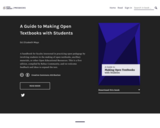
A handbook for faculty interested in practicing open pedagogy by involving students in the making of open textbooks, ancillary materials, or other Open Educational Resources. This is a first edition, compiled by Rebus Community, and we welcome feedback and ideas to expand the text.

Open pedagogy is the practice of engaging with students as creators of information rather than simply consumers of it. It's a form of experiential learning in which students demonstrate understanding through the act of creation. The products of open pedagogy are student created and openly licensed so that they may live outside of the classroom in a way that has an impact on the greater community.

The National Center on Accessible Educational Materials for Learning at CAST provides technical assistance, coaching, and resources to increase the availability and use of accessible educational materials and technologies for learners with disabilities across the lifespan.

We intend this book to act as a guide writ large for would-be champions of OER, that anyone—called to action by the example set by our chapter authors—might serve as guides themselves. The following chapters tap into the deep experience of practitioners who represent a meaningful cross section of higher education institutions in North America. It is our hope that the examples and discussions presented by our authors will facilitate connections among practitioners, foster the development of best practices for OER adoption and creation, and more importantly, lay a foundation for novel, educational excellence.

This starter kit has been created to provide instructors with an introduction to the use and creation of open educational resources (OER). The text is broken into five sections: Getting Started, Copyright, Finding OER, Teaching with OER, and Creating OER. Although some chapters contain more advanced content, the starter kit is primarily intended for users who are entirely new to Open Education. [Version 1.1. Revised September 5th, 2019.]

A poster describing similarities and differences between Open Access and Open Education

Open Educational Resources (OER) comprise
learning objects and tools that are freely
accessible through an open license, either
through the public domain or Creative Commons
licensing. Since OER are not beholden to rigid
publisher copyright, educators have agency over
their use of these resources. More specifically,
these open resources align with the 5Rs, which
allow users to retain, reuse, revise, remix, and
redistribute OER content (Wiley 2014)

Creative Commons is a free licensing system that allows the author of a work to specify legal permissions for how the work may be used others, while retaining full copyright to it themselves. Creative Commons licenses are not an alternative to copyright. They sit on the shoulders of copyright law, and allow authors to easily modify copyright terms to encourage collaboration and sharing.
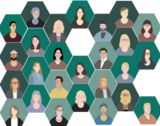
Fleming College faculty and our peers around the world are building a community patchwork of ‘chapters’ into a quasi-textbook about pedagogy for teaching & learning in higher education. Each patch of the quilt/chapter of the book focuses on one pedagogical skill and is completed and published by different individual faculty members from any institution wanting to join in.
Resource is also available in alternative format: https://openfacultypatchbook.org/

This guide provides resources on the topic of Open Pedagogy, as a supplement to the OERTX Digital Information Literacy Hub.
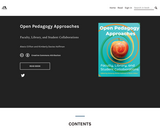
The entire spirit of this book project reflects the editors’ shared belief in the power of an open and inclusive community, of learning, and of collaboration toward innovation. From the outset, the editors knew that this book would be an open project in its own right. It had to be published openly (to practice what we preach), and it would serve as an opportunity to learn the process of creating an open book from start to finish, including, for example, developing review criteria that would ensure rigor, diversity, inclusion, and ingenuity while drawing from the open community to involve both novice and expert OP practitioners both as authors and readers.

This website is designed to serve as a resource for educators interested in learning more about Open Pedagogy.

This toolkit is intended as a guide for students who are engaging in open pedagogy. The toolkit defines open pedagogy, the benefits of open pedagogy, and the rights and responsibilities that come with being a student creator. Instructors may wish to use this toolkit as a resource to scaffold conversations about open pedagogy with their students and to appropriately prepare them for working in the open.

Open access is a publishing model that enables the free online accessibility of journal articles and scholarship, permitting any user to read and use these works. Open access fuels innovation through knowledge transfer by reducing barriers to reading discovery, and sharing.